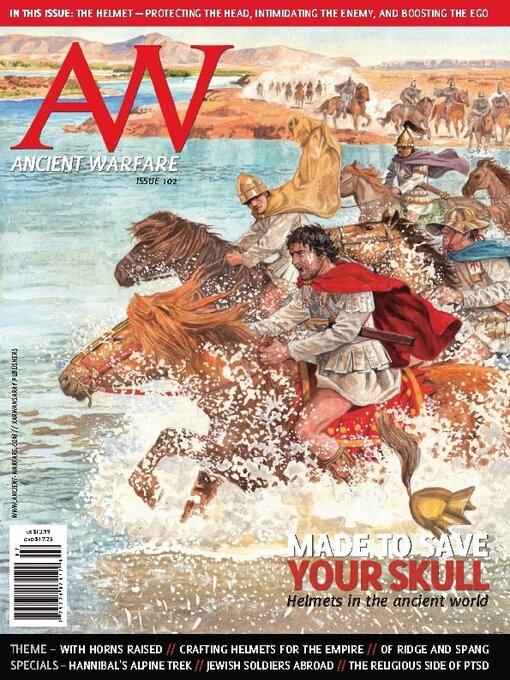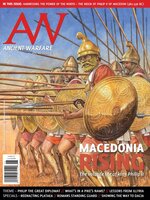Ancient Warfare is a unique publication focused exclusively on soldiers, battles, and tactics, all before 600 AD. Starting with ancient Egypt and Persia and continuing to the fall of the Western Roman Empire, Ancient Warfare examines the military history of cultures throughout Europe, the Middle East and parts of Asia and Africa. Ancient Greece and Rome receive the most frequent coverage, due both to the wealth of contemporary sources and the modern fascination with these two great civilizations. Subject-matter ranges from the familiar to the more obscure: while Alexander the Great, the Persian Wars and Caesar’s Gallic campaigns all receive regular coverage, Ancient Warfare also looks at some of the less common parts of ancient military history, from chariots as battle taxis to PTSD in antiquity.
Ancient Warfare Magazine
EDITORIAL — Helmets • NEWS ITEMS BY LINDSAY POWELL
Mass grave reveals Roman battle in Vienna
Roman bridgehead fort discovered in Austria
Egyptian troops at Megiddo
Besieged colony was larger than thought
Roman army horse cemetery found in Stuttgart
Big cat bite marks found on skeleton
PTSD IN ANCIENT GREECE • For at least 100 years, Herodotus’ story of Epizelus has been understood as the first recorded instance of either post-traumatic stress disorder (PTSD), a complex psychiatric injury from a traumatic event which leads to a long-term anxiety disorder, or a similar condition such as ‘shell shock’ or ‘hysterical blindness’. Researchers today disagree on the merits, or even possibility, of diagnosing such conditions in the past and it is widely recognized that there are unavoidable problems with using ancient texts like this for individual diagnosis. Even if Herodotus did record suitable information on this episode, he recorded it in an unsystematic way, and the ancient author's method, from his blending of myth and history to his unreliable use of sources, prevents his text from being used as a source of reliable information.
A PUZZLE WITHOUT AN ANSWER • Ever since the Renaissance, researchers have been trying to identify Hannibal's route across the Alps. They have wasted their time, energy, and intellect. The problem is not just utterly irrelevant, but also fundamentally unsolvable.
Elephant rafts
THOSE ABOUT TO DIE-OR NOT • Claudius surveyed the crowds who had come to see a mock naval battle. Unfortunately, the ships’ crews would not exactly play their parts.
AN ANCIENT CONNECTION • If you mention horned helmets, most people won't think of anything ancient at all. In fact, what comes to mind is entirely ahistorical horned Viking helmets! It is surprising just how common this idea is, despite its lack of a historical basis. This pervasive falsehood is often blamed on the composer Richard Wagner, and especially on his Der Ring des Nibelungen. Wagner's characters wore winged helmets, however, not horned ones. The phenomenon of the horned Viking helmet can nonetheless be traced to the nineteenth century, but the general idea of horned helmets is, in fact, an ancient one – a very ancient one.
ASSYRIAN HELMETS • For the three centuries of the Neo-Assyrian era (934/911-612 BC), the Assyrian army was active every campaigning season, conquering vast territories of the ancient Near East (see AW XIV.6). During that period, the Assyrian empire raised enormous armies and it is plausible to suppose that the ‘arms industry’ played a leading role in the Assyrian metal industry in both importance and magnitude in terms of orders and production. After all, an army 100,000–150,000 men strong needed a huge amount of equipment year by year. Unfortunately, this is hardly reflected in the archaeological record. In contrast to, for example, Assyria's rival state Urartu, hardly any pieces of Assyrian weaponry have survived the ages to appear in the excavated...

 AW XVIII.2
AW XVIII.2
 AW XVIII.1
AW XVIII.1
 AW XVII.6
AW XVII.6
 AW XVII.5
AW XVII.5
 AW XVII.4
AW XVII.4
 AW XVII.3
AW XVII.3
 AW XVII.2
AW XVII.2
 AW XVII.1
AW XVII.1
 AW XVI.6
AW XVI.6
 AW XVI.5
AW XVI.5
 AW XVI.4
AW XVI.4
 AW XVI.3
AW XVI.3
 AW XVI.2
AW XVI.2
 AW XVI.1
AW XVI.1
 AW XV.6
AW XV.6
 AW XV.5
AW XV.5
 AW XV.4
AW XV.4
 AW XV.3
AW XV.3